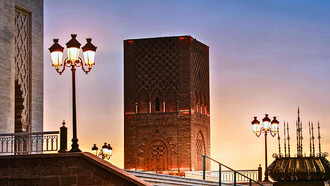In Aguascalientes, a small state north of Mexico City, we follow the dusty roads as they wind and twist up and down, passing through small villages and towns and then back into the high plains desert framed by the Sierra Fria and the Sierra del Laurel mountains. It’s a muted landscape of spiky cactus, feathery mesquite trees, and thick leafed aloes and agaves interspersed occasionally with orchards of pomegranate trees laden with red ripening fruit, the yellow apple-like globes clinging to tejocote trees, and vast tracks of vineyards dotted with red and white grapes. One of the major surprises for those first visiting is the profundity of grapes, as Aguascalientes is the fifth largest wine producer in the country.
The pallid palette changes quickly when we arrive in Calvillo, brightening into technicolor as we rumbled across cobblestone streets lined with buildings painted in a vivid array of pastels. Calvillo, founded in 1771, is a ‘‘Pueblo Mágico’’, one of 177 towns and villages designated by Mexico upon their historic architecture, beauty, uniquely regional dishes, a vibrant cultural heritage, and closeness to a major city. In this case, which would be Aguascalientes, the state capital and a bustling city of over a million that was established in 1575.
Guava
Among Calvillo’s food specialties are cheese and butter tamales, nopales (cactus leaves) and beans, and chamucos, cinnamon cookie filled with concha paste made of butter and sugar as distinct to the town but even more importantly and a major driver of the local economy, Calvillo is known as the world capital of the guava. And so, it seems fitting that our first stop takes us along ever narrowing streets rising up a hillside to Fruitland, a second generation family owned guava business edged by large groves of trees bearing the yellow and green fruit that grows so well in the climate here.
The tour is an educational and edible experience where we learn about the different types of guavas and, after a walk among the guava trees where the fruit is beginning to ripen, we enter the factory. Here, while workers shape guava pulp into candies, we taste logs of guava rolled in powders made of ground chiles, sugar, and cinnamon, sample salsas, moles and sauces made with guava, the latter used on a another of the town’s specialties, barbecued pork ribs while we sip guava liqueur and wine. The front of the factory also houses the gift shop and there’s a lot of traffic going in and out as people stop by to stock up on guava products including guava empanadas, jams, jellies, and guava rolls filled with cajeta, a Mexican caramel sauce made with sweetened goat’s milk.
There’s seemingly no end to what can be done with guava and on the town’s Guava Trail, a ten-minute stroll if you don’t include stops, we pass restaurants featuring guava pizzas and even a guava craft beer.
If that isn’t enough guava for you, the fruit also has its own celebration, the ‘‘Feria de la Guayaba’’, a festival which takes place at the beginning of December and features traditional folk dancing, music, charro and rodeo events, crafts, a queen contest, and lots of guava dishes to sample.
Distrito Histórico Central
Even outside of Fruitland, the sweet aroma of guava seems to float follow us, the sweet aroma thick in the air when we climb Andador Matamoros (Las Graditas), the wide stairway leading towards Plaza Principal, a pretty expanse of fountains, palm trees, flowers, and other greenery where many of the Calvillo’s historic sites are situated. Dominating the plaza is Parroquia del Señor del Salitre, Calvillo’s centuries old church, with its breathtaking interior of glitter, gold, and gilt accenting the three naves delineated by white alabaster columns, statuary, numerous arches, and what is said to be second largest dome in Latin America.
From there we visit the National Museum of Pueblos Mágicos, built to showcase and preserve the folklore, cuisine, traditions, and handicrafts that make these destinations so special. Another place not to miss is Casa de la Cultura, housed in what was once a private residence dating back to the 17th century. Its distinctive pink limestone facade is home to the Benito Juarez Public Library and exhibits promoting local artists, musician performances, and plays as well as workshops in traditional Mexican arts. If I had time, I would sign up for a class in folk dancing or to learn about the ancient art of El deshilado (unraveling), a craft practiced by the women of Aguascalientes where a fine hook-shaped needle is used to delicately unravel fabric to create intriguing designs including those made popular in the 1800s by Jose Guadalupe Posada, famed for his skulls and Caterinas, the stylish skeletons dressed in fancy Victorian-era finery. Many of the local shops sell this traditional Mexican folk art which is a rarity anywhere else.
Cuisine
While there are many restaurants and cafes in the city, a personal favorite is Quinta Los Granados. Part of a former mansion on a pomegranate estate, to reach the restaurant after parking, we follow a long open air corridor, its brick and stone walls lined with archways revealing vistas of small orchards and wrought iron fencing entangled with flowering vines. Thick wood doors are set in yellow stucco walls, pots overflowing with blooms and cacti are tucked away in carved niches. Inside the restaurant with its almost-jungle like atmosphere, stone terraces overlook fruiting trees, chandeliers hang from thatched ceilings held in place by thick timbers, interior walls are painted in startling bright pinks and yellows. In all, it’s a celebration of found art, decorative architectural salvage and antiques, beads and fairy lights.
The food matches the eclectic décor. Slabs of barbecue meat with, yes, choices of sauce including one made with guava, seafood on rounds of limes topped with slivers of pickled red onions, Aguascalientes-style chiles with guava, pools of refried beans and rice all served with large pitches of freshly made horchata (rice drink) and guava juice plus a large assortment of cocktails and wine are brought to the table on large trays to be enjoyed family style.
It's the perfect place to linger well into the night as lights sparkle in the surrounding orchards but there’s one more adventure and that’s to board El Guayequito, the tourist tram in the historic center that on Friday and Saturday nights travels along the Ruta de las Cantinas (Route of the cantinas). It’s an intimate look at the city, to explore the town’s classic bars and cantinas by hopping on and off during the three hour ride.















